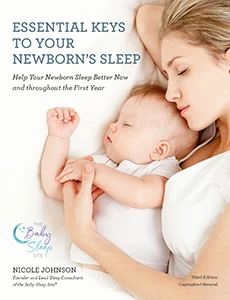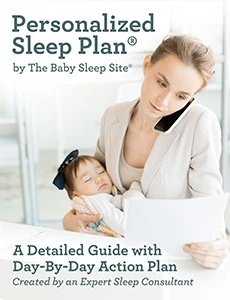
Some babies sleep through the night from an early age. But, some babies will eat in the middle of the night until 9 months old or longer. Some parents swear by a “dream feed” to help their babies sleep longer while others don’t like it. But, what is a dream feed, and at what age should you try it? Here’s all you need to know based on my 15+ years as a sleep consultant.
What Is a Dream Feed?
A dream feed is a feeding you give your baby while he or she is asleep before you go to bed yourself so they won’t wake up in the middle of the night.
Some moms breastfeed before they go to bed and others (or their partners) give their baby a bottle, sometimes without even picking up the baby.
The theory is that you will get a longer stretch of sleep, yourself. After all, if your baby can go 5 hours without eating, but goes to bed around 7 PM, that means you will need to feed the baby around 12 AM. That means your sleep is disrupted since you’ve possibly gone to bed at 10 PM.
That’s only two hours of sleep!
If you give a feeding to your baby around 10 PM, then it’s possible your baby won’t wake again until 3 AM giving you both a 5-hour stretch of sleep!
The questions are: Is it a good idea? Will it work? And, should you do it? For some people, a dream feed will be a Godsend. Not for others. Let’s explore this further!
You May Also Be Interested In:
At What Age Can You Dream Feed?
Most parents will start using a dream feed any time between 6-8 weeks old and 4 months old, once their baby no longer needs to eat every 3 hours at night. However, it’s not too late to try a dream feed even at 6 months old since many babies will increase their caloric needs around this time.
Most parents will continue to offer a dream feed until they are confident their baby can go all night without eating AND sleep a total of 11-12 hours without eating. Therefore, there’s no reason you couldn’t try it at 8 months old if night weaning isn’t working.
Keep in mind that if you stop the dream feed before your baby is ready, he or she may start to wake up too early for the day.
In my 15+ years of experience, most formula-fed or bottle-feeding babies can stop around 6-8 months old, and most breastfed babies can stop around 9-12 months old.
You May Also Be Interested In:
How To Dream Feed
To give your baby a dream feed, you simply feed your baby while he or she is still sleeping.
For example, your 5-month old baby goes to sleep around 7 p.m., you feed them around 10 p.m. before you go to bed, and your baby might sleep until 4 or 6 a.m. or later. This gives you a glorious 6 to 8 hours of sleep! If you go to bed early and have your partner/spouse give the dream feed, you can get even more sleep!
If your baby wakes up during the feeding, soothe them back to sleep as you would at bedtime. It may take a few nights for your baby to get used to it.
When it works, a dream feed is completely safe and a wonderful thing!
Sample Dream Feeding Scenario
Here’s an example of how a good scenario might look:
- Baby goes to sleep around 7 p.m. after your regular bedtime routine.
- You dream feed around 10 p.m. before you go to bed.
- Baby sleeps until 4 or 6 a.m. or later, giving you a glorious 6 to 8 hours of sleep straight. When your baby is older, they might even sleep through the night.
What Time Do You Dream Feed?
What time you do a dream feed will depend on your baby’s schedule as well as your own.
Usually, the dream feed is between 10 and 11:30 p.m., at least 3 hours from the bedtime feeding or longer. This is based on the assumption your baby is going to sleep between 6 and 8 p.m. and you plan to go to bed between 10 and 11:30 p.m.
As you can imagine, if your baby goes to bed around 8 p.m. and you go to bed around 9 p.m., you will not likely be able to do an early night feeding.
However, some parents will do a dream feed between 4 and 6 a.m. if they are trying to stop their baby from waking up too early. For example, your baby might be able to sleep through the night until 5 a.m. but then wakes up for the day. Way too early! You might set an alarm to feed the baby at 3 or 4 a.m. such that your baby sleeps through 6 or 7 a.m.
Full or Partial Feeding? How Many Ounces?
Should you offer a full or partial feeding as your dream feed?
A partial feeding might be just fine if your baby is only missing a few ounces of milk during the daytime. Perhaps they don’t need a big feeding and will sleep through the night afterward. In that scenario, it’s just fine to give your baby a partial feeding.
For a breastfed baby, that might mean a 5-minute feeding or just one breast. For a formula-fed baby, that might be a half-bottle which is usually around 3 ounces. If your baby needs less than this then it’s probably time to drop the dream feed (see below.)
However, in some cases, a partial feeding could mean the dream feed won’t work and your baby will wake later in the night or too early in the morning. In general, if your baby still needs a night feeding then you want your Dream Feed to be a full feeding.
A full feeding usually means a full 6-7-ounce formula bottle, a 4-5-ounce breastmilk bottle, or two breasts if breastfeeding. If your baby is younger and not yet taking larger feedings, then their feeding will be smaller. In other words, the Dream Feed should be the same size as a typical daytime feeding.
Do You Pick Up the Baby?
If you are breastfeeding, you will, of course, need to pick up the baby unless you are quite the acrobat!
If your baby is taking a bottle of breastmilk or formula, some babies will stay in their bed, finish a bottle, and continue sleeping. So, there is no need to pick them up, and it helps keep them asleep.
But, it’s not mandatory that you NOT pick up the baby. Most babies will be fine to be picked up. You should do whatever will keep the baby asleep and get the feeding done as fast as possible.
You May Also Be Interested In:
Do You Burp the Baby?
Yes, you will still burp the baby as usual. Keep in mind that as babies get older, they don’t always need help burping so you may not actually get a burp out of them. But, spend the normal amount of time you would burp the baby at a regular feeding time.
Do Dream Feeds Work?
Sometimes, yes. Unfortunately, not always.
As I explained how babies sleep at 4 months old, the first part of the night is the deepest sleep of the night for all babies and children over 4 months (approximately). Therefore, it might be very difficult to rouse your baby enough to feed any time you want to.
Some babies will awaken just enough to eat and stay asleep, but others might not wake up enough, and others will wake up too much. This might make them cranky that you woke them up (especially if they aren’t hungry!).
Dream feeds also seem to have a bit of an “expiration” date – generally speaking, they are most helpful for babies under 6 months old who may still require multiple night feedings.
Another way they sometimes “don’t work” is when you feed your baby before turning in for the night and they STILL wake up an hour or two later.
Some babies also tend to wake up even more frequently after the initial night feeding, so dream feeding does the opposite of what is intended.
Should You Dream Feed?
I don’t recommend dream feeds as a solution for ALL families, but they do work well for some babies. And, in the end, we need to find the “right” solution for each unique baby even within the same family.
Some people believe it goes against the idea of demand-feeding and is not respecting the baby to force a meal on him. If it feels “wrong” to you, then skip it. If you view it as helping your baby as much as it helps you, give it a try!
A baby’s tummy is small and as I always say, there are many adults who can’t go 11-12 hours without eating. I am not sure why we expect our babies to.
If you decide not to try it, or it doesn’t work, I typically recommend night-weaning to the appropriate number of night feedings for a baby your age and according to your baby’s capabilities.
How to Drop a Dream Feed
When you feel your baby is ready to drop the dream feed which is usually between 6 and 10 months old, it’s usually easiest to gradually make the dream feed smaller over a period of days and then stop it altogether. For example, if you are bottle-feeding, you might reduce the Dream Feed by one ounce per night for 3-4 nights and then stop offering it. If you are breastfeeding, try unlatching one minute earlier every night for a few nights.
The idea behind this method is they will curb their hunger with a smaller feeding but not get full. Then, they will adjust and eat more during the day to the point they won’t need the Dream Feed at all.
I hope this article has helped you decide whether you want to try a dream feed. Good luck!








